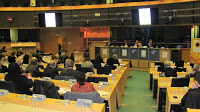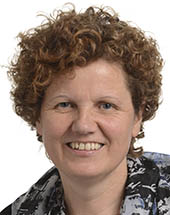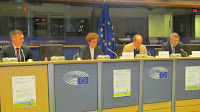 20 November 2017. Brussels. European Parliament. Regional perspectives on hunger and migration: the relevance of smart investment in food security and rural development
20 November 2017. Brussels. European Parliament. Regional perspectives on hunger and migration: the relevance of smart investment in food security and rural development
The recently released State of Food Security and Nutrition in the World 2017 report showed that after more than a decade of steady decline, global hunger is on the rise again, affecting 815 million
people in 2016 – up from 777 million in 2015.
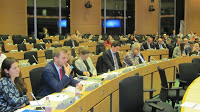 In light of this alarming increase, the European Parliamentary Alliance on the Fight Against Hunger brought together Members of the European Parliament as well as high-level representatives of the UN and leading international organisations to discuss long-term solutions geared towards achieving Zero Hunger. The debate placed links between food security, rural development and migration, aiming to investigate holistic responses to the root causes of hunger.
In light of this alarming increase, the European Parliamentary Alliance on the Fight Against Hunger brought together Members of the European Parliament as well as high-level representatives of the UN and leading international organisations to discuss long-term solutions geared towards achieving Zero Hunger. The debate placed links between food security, rural development and migration, aiming to investigate holistic responses to the root causes of hunger.
a particular emphasis on the
The event started with introductory remarks by MEP Paolo de
Castro, Coordinator of the Parliamentary Alliance, MEP Maria Heubuch (see picture), Member of the Development Committee and MEP Bogdan Brunon Wenta, Member of the Development Committee.
In a video speech Neven Mimica, European Commissioner for International Cooperation and Development, set the scene for the debate between:
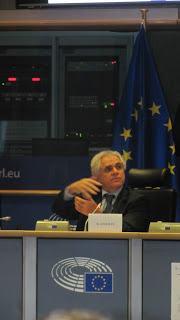
After a round of questions from the audience, , summarised and close the debate.
Resources:
At this event two booklets from the FAO were distributed:
MIGRATION AND PROTRACTED CRISES. Addressing the root causes and building resilient agricultural livelihoods (2016, 16 pages)
This booklet is directed towards FAO Member States, UN system and all other potential partners, and sheds light on the role that resilient agriculture livelihoods can play in addressing some of the root causes of migration in protracted crises and assisting displaced populations and host communities to cope with protracted displacement. The document aims at improving understanding of migration in situations of protracted crisis by explaining the context and providing examples of the work that FAO, together with its partners, has been doing across different countries to strengthen the resilience of communities and leave no one behind before, during and after protracted crises.
Diaspora can contribute to build the economy in countries of origin after a conflict or a crisis, through: remittances, skill transfer, diaspora connected FDI, direct investments such as diaspora entrepreneurship, heritage tourism and nostalgia trade, philanthropy, volunteerism and advocacy. (page 8)
HARNESSING THE POSITIVE CONTRIBUTION OF MIGRANTS AND DISPLACED PERSONS Generate evidence of the benefits of migrants and refugees for their host communities and countries of origin, especially by analysing remittances flows and use in rural areas of origin and destinations.(page 13)
Create partnerships and advocate for improving financial inclusion and literacy of displaced people originating from rural areas as well as diaspora communities, so that they can send remittances back home, as well as communities of origin to productively use the remittances they receive for agriculture and rural development. (page 15)

This publication highlights the work of FAO and its partners to strengthen the resilience of communities and to assist displaced populations and host communities in coping withprotracted displacement.
Extracts:
Migration itself can contribute to agriculture and rural development in the countries of origin. If the credit and/ or insurance markets in rural areas are absent or function poorly, remittances relax liquidity constraints, provide insurance in case of crisis/shocks and foster investment in agriculture and other rural economic activities with potential for job creation. Moreover, diaspora organizations and return migrants can help rural areas in the countries of origin through capital investments, skills and technology transfers, know-how and social networks. (page 9)
The 2018 edition of the State of Food and Agriculture (SOFA), one of FAO’s annual flagship publications, will focus on migration and the challenges it poses to food security as well as to peace and stability. A consultation on this topic was organised from 21.09.2017 – 16.10.2017.
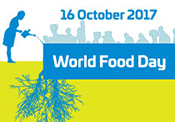
Source: PAEPARD FEED
by secretary
by secretary
by secretary
by secretary
by secretary
by secretary
by secretary
by secretary
by secretary
by secretary
by secretary
by secretary
by secretary
by secretary
by secretary
by secretary
by secretary
by secretary
by secretary
by secretary
by secretary
by secretary
by secretary
by secretary
by secretary
by secretary
by secretary
by secretary
by secretary
by secretary
by secretary
by secretary
by secretary
by secretary
by secretary
by secretary
by secretary
by secretary
by secretary
by secretary
by secretary
by secretary
by secretary
by secretary
by secretary
by secretary
by secretary
by secretary
by secretary
by secretary
by secretary
by secretary
by secretary
by secretary
by secretary
by secretary
by secretary
by secretary
by secretary
by secretary
by secretary
by secretary
by secretary
by secretary
by secretary
by secretary
by secretary
by secretary
by secretary
by secretary
by secretary
by secretary
by secretary
by secretary
by secretary
by secretary
by secretary
by secretary
by secretary
by secretary
by secretary
by secretary
by secretary
by secretary
by secretary
by secretary
by secretary
by secretary
by secretary
by secretary
by secretary
by secretary
by secretary
by secretary
by secretary
by secretary
by secretary
by secretary
by secretary
by secretary
by secretary
by secretary
by secretary
by secretary
by secretary
by secretary
by secretary
by secretary
by secretary
by secretary
by secretary
by secretary
by secretary
by secretary
by secretary
by secretary
by secretary
by secretary
by secretary
by secretary
by secretary
by secretary
by secretary
by secretary
by secretary
by secretary
by secretary
by secretary
by secretary
by secretary
by secretary
by secretary
by secretary
by secretary
by secretary
by secretary
by secretary
by secretary
by secretary
by secretary
by secretary
by secretary
by secretary
by secretary
by secretary
by secretary
by secretary
by secretary
by secretary
by secretary
by secretary
by secretary
by secretary
by secretary
by secretary
by secretary
by secretary
by secretary
by secretary
by secretary
by secretary
by secretary
by secretary
by secretary
by secretary
by secretary
by secretary
by secretary
by secretary
by secretary
by secretary
by secretary
by secretary
by secretary
by secretary
by secretary
by secretary
by secretary
by secretary
by secretary
by secretary
by secretary
by secretary
by secretary
by secretary
by secretary
by secretary
by secretary
by secretary
by secretary
by secretary
by secretary
by secretary
by secretary
by secretary
by secretary
by secretary
by secretary
by secretary
by secretary
by secretary
by secretary
by secretary
by secretary
by secretary
by secretary
by secretary
by secretary
by secretary
by secretary
by secretary
by secretary
by secretary
by secretary
by secretary
by secretary
by secretary
by secretary
by secretary
by secretary
by secretary
by secretary
by secretary
by secretary
by secretary
by secretary
by secretary
by secretary
by secretary
by secretary
by secretary
by secretary
by secretary
by secretary
by secretary
by secretary
by secretary
by secretary
by secretary
by secretary
by secretary
by secretary
by secretary
by secretary
by secretary
by secretary
by secretary
by secretary
by secretary
by secretary
by secretary
by secretary
by secretary
by secretary
by secretary
by secretary
by secretary
by secretary
by secretary
by secretary
by secretary
by secretary
by secretary
by secretary
by secretary
by secretary
by secretary
by secretary
by secretary
by secretary
by secretary
by secretary
by secretary
by secretary
by secretary
by secretary
by secretary
by secretary
by secretary
by secretary
by secretary
by secretary
by secretary
by secretary
by secretary
by secretary
by secretary
by secretary
by secretary
by secretary
by secretary
by secretary
by secretary
by secretary
by secretary
by secretary
by secretary
by secretary
by secretary
by secretary
by secretary
by secretary
by secretary
by secretary
by secretary
by secretary
by secretary
by secretary
by secretary
by secretary
by secretary
by secretary
by secretary
by secretary
by secretary
by secretary
by secretary
by secretary
by secretary
by secretary
by secretary
by secretary
by secretary
by secretary
by secretary
by secretary
by secretary
by secretary
by secretary
by secretary
by secretary
by secretary
by secretary
by secretary
by secretary
by secretary
by secretary
by secretary
by secretary
by secretary
by secretary
by secretary
by secretary
by secretary
by secretary
by secretary
by secretary
by secretary
by secretary
by secretary
by secretary
by secretary
by secretary
by secretary
by secretary
by secretary
by secretary
by secretary
by secretary
by secretary
by secretary
by secretary
by secretary
by secretary
by secretary
by secretary
by secretary
by secretary
by secretary
by secretary
by secretary
by secretary
by secretary
by secretary
by secretary
by secretary
by secretary
by secretary
by secretary
by secretary
by secretary
by secretary
by secretary
by secretary
by secretary
by secretary
by secretary
by secretary
by secretary
by secretary
by secretary
by secretary
by secretary
by secretary
by secretary
by secretary
by secretary
by secretary
by secretary
by secretary
by secretary
by secretary
by secretary
by secretary
by secretary
by secretary
by secretary
by secretary
by secretary
by secretary
by secretary
by secretary
by secretary
by secretary
by secretary
by secretary
by secretary
by secretary
by secretary
by secretary
by secretary
by secretary
by secretary
by secretary
by secretary
by secretary
by secretary
by secretary
by secretary
by secretary
by secretary
by secretary
by secretary
by secretary
by secretary
by secretary
by secretary
by secretary
by secretary
by secretary
by secretary
by secretary
by secretary
by secretary
by secretary
by secretary
by secretary
by secretary
by secretary
by secretary
by secretary
by secretary
by secretary
by secretary
by secretary
by secretary
by secretary
by secretary
by secretary
by secretary
by secretary
by secretary
by secretary
by secretary
by secretary
by secretary
by secretary
by secretary
by secretary
by secretary
by secretary
by secretary
by secretary
by secretary
by secretary
by secretary
by secretary
by secretary
by secretary
by secretary
by secretary
by secretary
by secretary
by secretary
by secretary
by secretary
by secretary
by secretary
by secretary
by secretary
by secretary
by secretary
by secretary
by secretary
by secretary
by secretary
by secretary
by secretary
by secretary
by secretary
by secretary
by secretary
by secretary
by secretary
by secretary
by secretary
by secretary
by secretary
by secretary
by secretary
by secretary
by secretary
by secretary
by secretary
by secretary
by secretary
by secretary
by secretary
by secretary
by secretary
by secretary
by secretary
by secretary
by secretary
by secretary
by secretary
by secretary
by secretary
by secretary
by secretary
by secretary
by secretary
by secretary
by secretary
by secretary
by secretary
by secretary
by secretary
by secretary
by secretary
by secretary
by secretary
by secretary
by secretary
by secretary
by secretary
by secretary
by secretary
by secretary
by secretary
by secretary
by secretary
by secretary
by secretary
by secretary
by secretary
by secretary
by secretary
by secretary
by secretary
by secretary
by secretary
by secretary
by secretary
by secretary
by secretary
by secretary
by secretary
by secretary
by secretary
by secretary
by secretary
by secretary
by secretary
by secretary
by secretary
by secretary
by secretary
by secretary
by secretary
by secretary
by secretary
by secretary
by secretary
by secretary
by secretary
by secretary
by secretary
by secretary
by secretary
by secretary
by secretary
by secretary
by secretary
by secretary
by secretary
by secretary
by secretary
by secretary
by secretary
by secretary
by secretary
by secretary
by secretary
by secretary
by secretary
by secretary
by secretary
by secretary
by secretary
by secretary
by secretary
by secretary
by secretary
by secretary
by secretary
by secretary
by secretary
by secretary
by secretary
by secretary
by secretary
by secretary
by secretary
by secretary
by secretary
by secretary
by secretary
by secretary
by secretary
by secretary
by secretary
by secretary
by secretary
by secretary
by secretary
by secretary
by secretary
by secretary
by secretary
by secretary
by secretary
by secretary
by secretary
by secretary
by secretary
by secretary
by secretary
by secretary
by secretary
by secretary
by secretary
by secretary
by secretary
by secretary
by secretary
by secretary
by secretary
by secretary
by secretary
by secretary
by secretary
by secretary
by secretary
by secretary
by secretary
by secretary
by secretary
by secretary
by secretary
by secretary
by secretary
by secretary
by secretary
by secretary
by secretary
by secretary
by secretary
by secretary
by secretary
by admin
by admin
by admin
by admin
by admin
by admin
by admin
by admin
by admin

